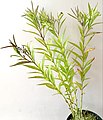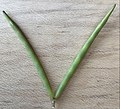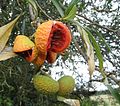Apocynaceae
 From Wikipedia - Reading time: 15 min
From Wikipedia - Reading time: 15 min
| Apocynaceae | |
|---|---|
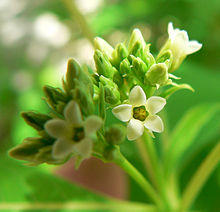
| |
| Apocynum cannabinum | |
| Scientific classification | |
| Kingdom: | Plantae |
| Clade: | Tracheophytes |
| Clade: | Angiosperms |
| Clade: | Eudicots |
| Clade: | Asterids |
| Order: | Gentianales |
| Family: | Apocynaceae Juss. |
| Type genus | |
| Apocynum | |
| Synonyms | |
Apocynaceae (/əˌpɑːsəˈneɪsiˌaɪ, -siːˌiː/, from Apocynum, Greek for "dog-away") is a family of flowering plants that includes trees, shrubs, herbs, stem succulents, and vines, commonly known as the dogbane family,[1] because some taxa were used as dog poison.[when?][2] Members of the family are native to the European, Asian, African, Australian, and American tropics or subtropics, with some temperate members.[1] The former family Asclepiadaceae (now known as Asclepiadoideae) is considered a subfamily of Apocynaceae and contains 348 genera. A list of Apocynaceae genera may be found here.
Many species are tall trees found in tropical forests, but some grow in tropical dry (xeric) environments. Also perennial herbs from temperate zones occur. Many of these plants have milky latex, and many species are poisonous if ingested, the family being rich in genera containing alkaloids and cardiac glycosides, those containing the latter often finding use as arrow poisons. Some genera of Apocynaceae, such as Adenium, bleed clear sap without latex when damaged, and others, such as Pachypodium, have milky latex apart from their sap.
Description
[edit]
Growth pattern
[edit]The dogbane/milkweed[2] family includes annual plants, perennial herbs, stem succulents, woody shrubs, trees, or vines.[1][3] Most exude a milky latex when cut.[4]
Leaves and stems
[edit]Leaves are simple. They may appear one at a time (singly) with each occurrence on alternating sides of the stem,[3] but usually occur in pairs (and rarely in whorls).[1] When paired, they occur on opposite sides of the stem (opposite), with each pair occurring at an angle rotated 90° to the pair below it (decussate).
There is no stipule (a small leaf-like structure at the base of the leaf stem), or stipules are small and sometimes finger-like.[3]
Inflorescence and fruit
[edit]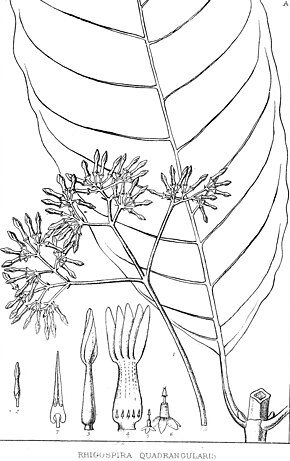
Flowers have radial symmetry (actinomorphic),[1] and are borne in heads that are cymes or racemes, or are solitary in axils.[6] They are perfect (bisexual), with a synsepalous, five-lobed calyx united into a tube at the base.[1][6] Inflorescences are terminal or axillary. Five petals are united into a tube with four or five epipetalous stamens.[1] The style head is swollen.[7] The pollen is transported in foam.[7] The ovary is usually superior, bicarpellary, and apocarpous,[1] with a common fused style and stigma. (Fig. 5. and Fig.6. in the illustration of Rhigospira quadrangularis show a typical tripartite style which divides into three zones (specialised for pollen deposition, viscin secretion, and the reception of pollen).[8]
The fruit is a drupe, a berry, a capsule, or a (frequently paired) follicle.[1] The seeds are often winged or have appendages of long silky hairs.[9]
Taxonomy
[edit]As of 2012, the family was described as comprising some 5,100 species, in five subfamilies:[10]
- Apocynoideae Burnett, 1835
- Asclepiadoideae Burnett, 1835 (incorporating the Asclepiadaceae)
- Periplocoideae Endl., 1838
- Rauvolfioideae Kostel., 1834
- Secamonoideae Endl., 1838
The former family Asclepiadaceae is included in Apocynaceae according to the Angiosperm Phylogeny Group III (APG III) modern, largely molecular-based system of flowering plant taxonomy.[11] An updated classification, including 366 genera, 25 tribes, and 49 subtribes, was published in 2014.[12]
376 genera are currently accepted.[13]
Distribution and habitat
[edit]This section needs additional citations for verification. (June 2024) |
Species in this family are distributed mainly in tropical regions:
- In the tropical forests and swamps of Indomalaya: small to very tall evergreen trees up to 80 m (260 ft) tall, often with buttress roots, such as Alstonia and Dyera.
- In Australia: occurs in all habitats; about 46 genera and about 200 species, including about 20 naturalised; herbs, vines, shrubs and trees.[14][15][16]
- In deciduous forests of Africa, India, and Indo-China: smaller trees such as Carissa, Wrightia, and Holarrhena
- In tropical America, India, Myanmar, and Malaya: evergreen trees and shrubs, such as Rauvolfia, Tabernaemontana, and Acokanthera.
- In Central America: Plumeria, or the frangipani, with its waxy white or pink flowers and a sweet scent.
- In South America, Africa, and Madagascar: many lianas, such as Landolphia
- In the Mediterranean region: Nerium, with the well-known oleander or be-still tree (Nerium oleander), and Apple of Sodom (Calotropis procera), with other (Calotropis) species extending into South Asia.
- The only genera found in temperate Europe away from the Mediterranean are Vinca (Rauvolfioideae) and Vincetoxicum (Asclepiadoideae). Also Asclepias syriaca is an invasive weed (e. g., in many areas of Ukraine).
- In North America: Apocynum, dogbane or Indian hemp, including Apocynum cannabinum, a traditional source of fiber. Also the bluestars, Amsonia, herbaceous perennials of upright habit, grown as ornamental plants for their attractive flowers.
- In continental southern Africa (Angola, Botswana, Eswatini, Mozambique, South Africa, and Zimbabwe) and Madagascar, except for the humid evergreen forest of the eastern side of Madagascar, and never above 2,000 m (6,600 ft) for the entire island: Pachypodium and Fockea.
Ecology
[edit]Several genera are preferred larval host plants for the Queen Butterfly (Danaus gilippus).[17]
Toxicity
[edit]Many species of plants from the family Apocynaceae have some toxicity, with some being extremely poisonous if parts are ingested, or if they are not handled properly. Genera containing cardiac glycosides—Cerbera, Nerium, Asclepias, Cascabela, Strophanthus,[6] Acokanthera,[18] Apocynum,[19] Thevetia,[20] etc.—have therapeutic ranges, but are often associated with accidental poisonings, in many cases lethal (see below). Alkaloid-producing species like Rauvolfia serpentina, Catharanthus roseus, and Tabernanthe iboga are likewise the source of compounds with therapeutic ranges, but which have significant associated toxicities if not taken in appropriate doses and in controlled fashion. (See below)
Uses
[edit]Several members of the family Apocynaceae have had economic uses in the past. Several are sources of important natural products—pharmacologic tool compounds and drug research candidates, and in some cases actual prescription drugs. Cardiac glycosides, which affect heart function, are a ready example. Genera studied and known to contain such glycosides include Acokanthera, Apocynum, Cerbera, Nerium, Thevetia and Strophanthus. Rauvolfia serpentina (Indian snakeroot) contains the alkaloid reserpine, which has been used as an antihypertensive and an antipsychotic drug but its adverse effects limit its clinical use.[21] Catharanthus roseus yields alkaloids used in the treatment of cancer.[22][23] Tabernanthe iboga, Voacanga africana, and Tabernaemontana undulata contain the alkaloid ibogaine, which is a psychedelic drug which may help with drug addiction, but which has significant adverse effects,[24][25] with ibogaine being both cardiotoxic and neurotoxic.[26] Ajmalicine, an alkaloid found in Rauvolfia spp., Catharanthus roseus, and Mitragyna speciosa,[27][28][29] is an antihypertensive drug used in the treatment of high blood pressure.[27]
Many genera are grown as ornamental plants, including Amsonia (bluestar),[30] Nerium (oleander),[31] Vinca (periwinkle),[32] Carissa (Natal plum),[33] Allamanda (golden trumpet),[34] Plumeria (frangipani),[35] Thevetia,[36] Mandevilla (Savannah flower),[37] and Adenium (desert-rose).[38]
In addition, the genera Landolphia, Carpodinus, and Mascarenhasia have been used as commercial sources of inferior rubber.[39] (See Congo rubber)
There are limited dietary uses of plants from this family. The flower of Echites panduratus (common name: loroco) is edible.[40] Carissa (Natal plum) produces an edible fruit, but all other parts of the plant are poisonous.[41] The genus Apocynum was reportedly used as a source of fiber by Native Americans.[42] The aromatic fruit juice from Saba comorensis (syn. Landolphia comorensis, the Bungo or Mbungo fruit) is used as a drink.[43]
Finally, ethnopharmacologic and ethnotoxicologic uses are also known. The roots of Tabernanthe iboga and certain Voacanga species have traditionally been used ceremonially as hallucinogens in Africa. The ibogaine-type alkaloids responsible for the psychoactivity of these plants have been studied with regard to the treatment of drug addiction.[24] The juice of Acokanthera species such as A. venenata and the milky juice of the Namibian Pachypodium have been used as poison for arrow tips.[44]
Many species are ornamental in gardens or as houseplants.
Gallery
[edit]Flowers
[edit]-
Aspidosperma quebracho-blanco illustration in Köhler's Medizinal-Pflanzen
-
Cascabela thevetia (syn. Thevetia peruviana)
-
Pachypodium lamerei growth habit
-
Tabernanthe iboga in flower and fruit
-
Wrightia tinctoria single flower
Fruits
[edit]-
Adenium obesum dehiscence of single fruit.
-
Amsonia tabernaemontana containerised specimen in fruit
-
Amsonia tabernaemontana single paired follicle detached from plant (paler, unsunned side)
-
Asclepias syriaca dehiscent follicles (before unfurling of pappi)
-
Asclepias curassavica dehiscent follicles shedding seeds with unfurled pappi
-
Cascabela thevetia (syn.Thevetia peruviana)
-
Cascabela thevetia (syn.Thevetia peruviana): dissection of toxic fruits.
-
Nerium oleander (dehiscence)
-
Saba senegalensis unripe fruit
-
Saba senegalensis: dissection of ripe, edible fruit
-
Strophanthus speciosus (dehiscence)
-
Tabernaemontana catharinensis (dehiscence)
-
Trachelospermum jasminoides (dehiscence)
-
Trachelospermum jasminoides: individual seeds, showing pappus
-
Vinca major (seeds)
-
Vinca minor: botanical plate showing paired fruits (no. 5)
Pachycaul species
[edit]-
Adenium obesum growth habit of wild specimens, Tanzania
-
Adenium obesum close-up of colossal specimen, Ghana
-
Adenium obesum trunk of extreme pachycaul specimen, Socotra
-
Pachypodium lamerei wild specimen of maximum height (approx 6 m (20 ft)) attained by species
-
Pachypodium lamerei in flower
-
Pachypodium lamerei mature, multi-trunked specimen cultivated in glasshouse
References
[edit]- ^ a b c d e f g h i Endress ME, Bruyns PV (2000). "A revised classification of the Apocynaceae s.l." (PDF). The Botanical Review. 66 (1): 1–56. Bibcode:2000BotRv..66....1E. doi:10.1007/BF02857781. S2CID 31739212.
- ^ a b Simpson, Michael George (2010). Plant Systematics. Academic Press. ISBN 9780123743800.
- ^ a b c Apocynaceae, Thomas Rosatti, Jepson Herbarium
- ^ "Apocynaceae usually have copious latex and the leaves are often opposite and with colleters...", retrieved 3/10/18 from ANGIOSPERM PHYLOGENY WEBSITE, version 13 http://www.mobot.org/MOBOT/Research/APweb/
- ^ Miers, J. (1878). On the Apocynaceae of South America, with some preliminary remarks on the whole family. p. 269.
- ^ a b c "PlantNET - FloraOnline: Apocynaceae". plantnet.rbgsyd.nsw.gov.au. Retrieved 2020-05-29.
- ^ a b "Stevens, P. F. (2001 onwards). Angiosperm Phylogeny Website. Version 14, July 2017 [and more or less continuously updated since]". Angiosperm Phylogeny Website. Retrieved 2020-05-30.
- ^ Judd, W.S.; Campbell, C.S.; Kellogg, E.A.; Stevens, P.F.; Donoghue, M.J. (January 2015). Plant systematics A phylogenetic approach (4 ed.). Sunderland, MA: Sinauer Associates, Inc. p. 500. ISBN 9781605353890.
- ^ "Apocynaceae Juss. | Plants of the World Online | Kew Science". Plants of the World Online. Retrieved 2020-05-29.
- ^ Nazia Nazar, David J. Goyder, James J. Clarkson, Tariq Mahmood and Mark W. Chase, 2013, "The taxonomy and systematics of Apocynaceae: Where we stand in 2012," Bot. J. Linn. Soc., 171(3, March), pp. 482–490, see [1], accessed 22 June 2015.
- ^ Angiosperm Phylogeny Group (2009). "An update of the Angiosperm Phylogeny Group classification for the orders and families of flowering plants: APG III". Bot. J. Linn. Soc. 161 (2): 105–121. doi:10.1111/j.1095-8339.2009.00996.x. hdl:10654/18083.
- ^ Endress M.E., Liede-Schumann S. & Meve U. (2014). "An updated classification for Apocynaceae" (PDF). Phytotaxa. 159 (3): 175–194. doi:10.11646/phytotaxa.159.3.2.
- ^ Apocynaceae Juss. Plants of the World Online. Retrieved 24 July 2023.
- ^ "Search: species: Apocynaceae | Occurrence records". Australasian Virtual Herbarium. Australian Government. Retrieved 1 July 2024.
- ^ Ohlsen, D.J.; Forster, P.I. (2022). Kodela, P.G. (ed.). "Apocynaceae". Flora of Australia. Australian Biological Resources Study, Department of Climate Change, Energy, the Environment and Water: Canberra. Retrieved 1 July 2024.
- ^ F.A.Zich; B.P.M.Hyland; T.Whiffen; R.A.Kerrigan (2020). "Apocynaceae". Australian Tropical Rainforest Plants Edition 8 (RFK8). Centre for Australian National Biodiversity Research (CANBR), Australian Government. Retrieved 1 July 2024.
- ^ Klots, Alexander B. (1951). A Field Guide to the Butterflies of North America, East of the Great Plains. Cambridge, Massachusetts: The Riverside Press. pp. 77–79.
- ^ de Mello, J.P. (1965). "Offensive weapons of the world 3. Kenya arrow poison". Med. Sci. & L. 5: 44–5. doi:10.1177/002580246500500111. PMID 14269673. S2CID 208362795 – via HeinOnline.
- ^ Irie, K.; Sato, T.; Tanaka, I.; Nakajima, J.; Kawaguchi, M.; Himi, T. (2009). "Cardiotonic effect of Apocynum venetum L. extracts on isolated guinea pig atrium". Journal of Natural Medicines. 63 (2): 111–116. doi:10.1007/s11418-008-0296-2. ISSN 1340-3443. PMID 19002560. S2CID 12653850.
- ^ Kohls, S.; Scholz-Böttcher, B.M.; Teske, J.; Zark, Patrick; Rullkötter, J. (2012). "Cardiac glycosides from Yellow Oleander (Thevetia peruviana) seeds". Phytochemistry. 75: 114–127. Bibcode:2012PChem..75..114K. doi:10.1016/j.phytochem.2011.11.019. PMID 22196940.
- ^ "reserpine". drugcentral.org. Retrieved 2020-05-31.
- ^ Arora, R., Malhotra, P., Mathur, A.K., Mathur, A., Govil, C.M., Ahuja, P.S. (2010). "Chapter 21 Anticancer Alkaloids of Catharanthus roseus: Transition from Traditional to Modern Medicine". Herbal Medicine: A Cancer Chemopreventive and Therapeutic Perspective (1 ed.). Jaypee Brothers Medical Publishers Pvt. Limited. pp. 292–310. ISBN 9788184488418. Retrieved 2020-06-01.
{{cite book}}: CS1 maint: multiple names: authors list (link) - ^ Simpson, M.G. (2010). Plant Systematics. Elsevier. p. 397. ISBN 9780123743800.
- ^ a b Koenig X, Hilber K (January 2015). "The anti-addiction drug ibogaine and the heart: a delicate relation". Molecules. 20 (2): 2208–28. doi:10.3390/molecules20022208. PMC 4382526. PMID 25642835.
- ^ Zdrojewicz Z, Kuszczak B, Olszak N. (2016). "Ibogaina – budowa, wpływ na organizm człowieka, znaczenie kliniczne [Ibogaine - structure, influence on human body, clinical relevance]". Pol Merkur Lekarski. (in Polish). 41 (241): 50–55. PMID 27734823.
{{cite journal}}: CS1 maint: multiple names: authors list (link) - ^ Wasko, M.J.; Witt-Enderby, P.A.; Surratt, C.K. (2018-10-17). "DARK Classics in Chemical Neuroscience: Ibogaine". ACS Chemical Neuroscience. 9 (10): 2475–2483. doi:10.1021/acschemneuro.8b00294. ISSN 1948-7193. PMID 30216039. S2CID 52277862.
- ^ a b Wink, Michael; Roberts, M. W. (1998). Alkaloids: biochemistry, ecology, and medicinal applications. New York: Plenum Press. ISBN 0-306-45465-3.
- ^ Kurz WG, Chatson KB, Constabel F, et al. (May 1981). "Alkaloid Production in Catharanthus roseus Cell Cultures VIII1". Planta Medica. 42 (5): 22–31. doi:10.1055/s-2007-971541. PMID 17401876. S2CID 28177495.
- ^ León F, Habib E, Adkins JE, Furr EB, McCurdy CR, Cutler SJ (July 2009). "Phytochemical characterization of the leaves of Mitragyna speciosa grown in U.S.A". Natural Product Communications. 4 (7): 907–10. doi:10.1177/1934578X0900400705. PMC 9255435. PMID 19731590. S2CID 37709142.
- ^ "StackPath: Growing Amsonia". www.gardeningknowhow.com. 22 June 2013. Retrieved 2020-06-01.
- ^ "Oleander". Better Homes & Gardens. Retrieved 2020-06-01.
- ^ "Annual Vinca". Better Homes & Gardens. Retrieved 2020-06-01.
- ^ "Carissa macrocarpa - Useful Tropical Plants". tropical.theferns.info. Retrieved 2020-06-01.
- ^ Agriculture and Fisheries (2015-10-30). "Yellow allamanda". www.business.qld.gov.au. Retrieved 2020-06-01.
- ^ "PLUMERIA RUBRA: AN OLD ORNAMENTAL, A NEW CROP". www.actahort.org. Retrieved 2020-06-01.
- ^ "Factsheet - Thevetia peruviana (Yellow Oleander)". keys.lucidcentral.org. Retrieved 2020-06-01.
- ^ "Propagating Mandevilla: Using Mandevilla Cuttings Or Seeds To Propagate Mandevilla Vine". 14 September 2010.
- ^ Archived at Ghostarchive and the Wayback Machine: Desert Rose Plant: How to Grow Desert Rose and Adeniums, retrieved 2020-06-01
- ^ Western Australian Herbarium. "FloraBase—the Western Australian Flora:Apocynaceae". florabase.dpaw.wa.gov.au. Biodiversity and Conservation Science. Retrieved 2020-05-29.
- ^ "Loroco: flower buds used as an herb". CooksInfo. Retrieved 2020-05-31.
- ^ "Floridata: Carissa macrocarpa (Natal plum)". floridata.com. Retrieved 2020-05-31.
- ^ Coville, F. V. (1897). "Notes On The Plants Used By The Klamath Indians Of Oregon" (PDF). Contributions from the U.S. National Herbarium. VII (3): 295–408–108 (p. 379). Archived from the original (PDF) on 2016-03-04. Retrieved 2020-05-29.
- ^ "Saba comorensis in Agroforestree Database" (PDF). Retrieved 30 July 2012.
- ^ "Pachypodium | PlantZAfrica". pza.sanbi.org. Retrieved 2020-05-31.
External links
[edit]- Apocynaceae in BoDD – Botanical Dermatology Database
 Media related to Apocynaceae at Wikimedia Commons
Media related to Apocynaceae at Wikimedia Commons Data related to Apocynaceae at Wikispecies
Data related to Apocynaceae at Wikispecies
Further reading
[edit]- A review on antimicrobial botanicals, phytochemicals and natural resistance modifying agents from Apocynaceae family: Possible therapeutic approaches against multidrug resistance in pathogenic microorganisms. doi:10.1016/j.drup.2020.100695
 KSF
KSF














































